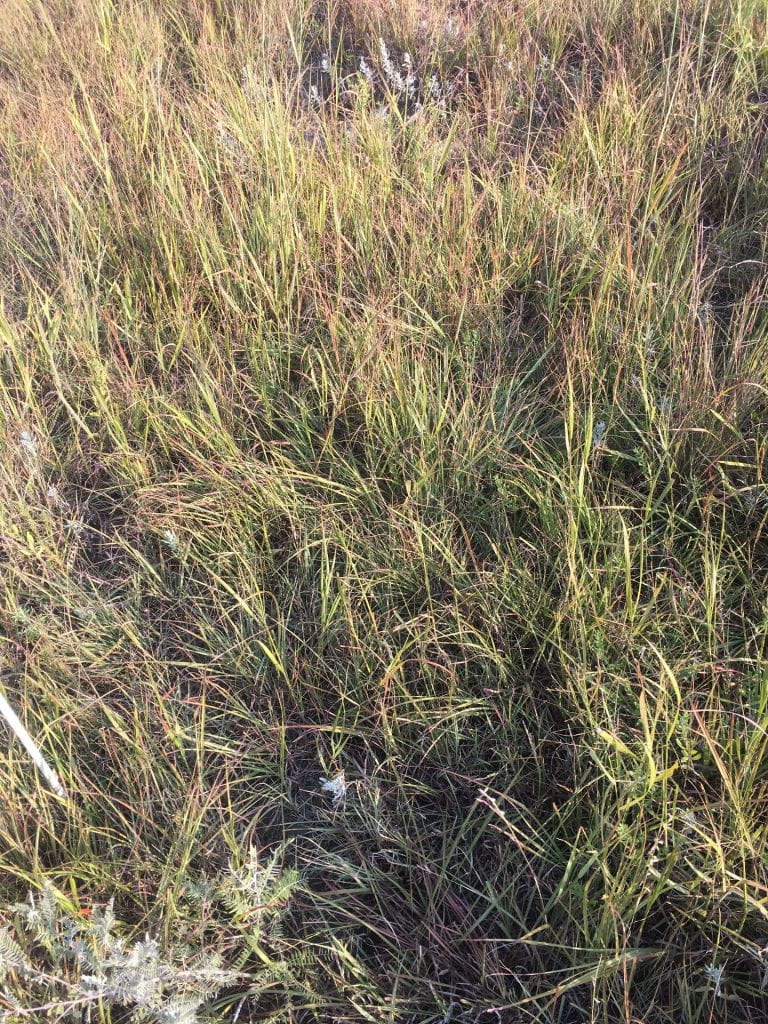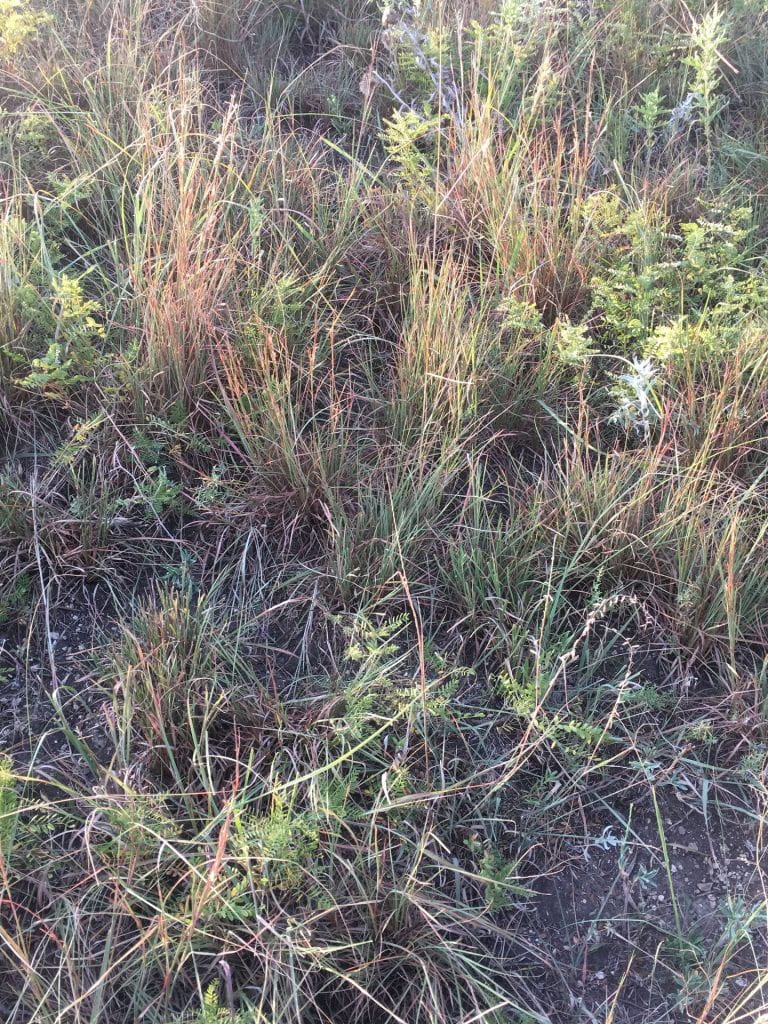by Keith Harmoney, Range Scientist, Hays
Over the years, I’ve heard rangeland managers develop rules of thumb, or short phrases, to try to help them simplify decisions that need to be made to manage their pastures. Some of these rules of thumb have merit and scientific or economic data to support the rules of thumb; however, some rules of thumb may be unfounded and lack informational support. In previous Beef Tips Newsletters, I listed some common rules of thumb, along with an explanation of whether or not the rule of thumb has any merit or basis of support. You can go back and read Rules of Thumb 1-4 in the January Beef Tips, and Rules of Thumb 5-8 in the March Beef Tips. This month, another four Rules of Thumb are listed, and a Thumbs Up means it’s a rule of thumb with merit, and a Thumbs Down indicates the rule of thumb lacks support and has room for improvement. A Thumbs Up and a Thumbs Down means that arguments may be made for and against the rule of thumb.
- Every i
 nch of growth is equal to 150 lb/acre. – Thumbs Up and Thumbs Down.
nch of growth is equal to 150 lb/acre. – Thumbs Up and Thumbs Down.
It’s a good practice to estimate how many pounds of forage are still available in a currently grazed pasture or a pasture waiting to be grazed. Knowing the height of the forage helps to estimate the quantity available. The rule that each inch of growth is equal to 150 lb forage /acre is a satisfactory rule to help calculate forage yield by measuring grass height in an average native grass stand in the middle of the state. But, that rule will change depending on the location of the pasture and the density of the grass stand. In eastern Kansas rangelands, more robust tallgrass species and thick, high density stands of grass could result in 250 lb forage/acre for every inch of growth. In average density western Kansas shortgrass, the value could decline to 60-70 lb forage/acre for every inch of growth. So, the forage quantity produced for every inch of growth depends on the dominant grass species present and the density of the grass stand. Some general estimates of forage production per inch of growth for different locations and densities of grass stands throughout the state are listed in Table 1.
| Table 1. General guidelines for forage yield per inch of forage growth for eastern Kansas tallgrass to western Kansas shortgrass rangelands. | |||
| Density lb/acre/inch, dry matter basis | |||
| Rangeland Type | Low | Medium | High |
| Tallgrass | 120-160 | 160-230 | 230-300 |
| Mixed-grass | 70-120 | 120-160 | 160-230 |
| Shortgrass | 30-40 | 40-80 | 80-120 |
Pasture yield estimates derived by measuring forage height and multiplying by these yield per inch of growth factors may not be as exact as clipping and weighing samples, but measuring height and using these estimates will allow for many more height samples to be collected at many more locations in the same amount of time as clipping. Estimating forage yield is one of the first steps necessary in calculating proper stocking rates to balance forage produced with forage removed through grazing.


 Don’t graze the same place at the same time every year. – Thumbs Up.
Don’t graze the same place at the same time every year. – Thumbs Up.
This rule generally refers to pastures with mixed vegetation, both cool-season and warm-season grass species. Grazing in the same place at the same time every year can result in shifting the plants present in the pasture to mostly cool-season or mostly warm-season species. Composition will shift to species that grow best in the period of the growing season opposite of the period when the pasture is regularly grazed. Grazing reduces the leaf area and vigor of the species being actively defoliated, so species that are not yet growing well or grow best during a different time period will avoid defoliation and will have more growth and vigor during the ungrazed period. For example, in a mixed grass pasture in central Kansas or shortgrass pasture of western Kansas with both common native cool-season and warm-season grasses, repeatedly deferring grazing until the end of June or early July year after year will increase the cool-season grass composition over time and reduce warm-season grasses. Likewise, concentrated grazing in April and May every year will end up decreasing desirable western wheatgrass in that pasture. However, the same repeated early-season grazing concept could help promote pasture improvement in eastern Kansas warm-season grass pasture that has been invaded over the years by smooth brome, tall fescue, or Kentucky bluegrass. Concentrated early grazing could help to shift composition toward more warm-season species and reduce the cover of invading cool-season grasses.
 It’s hard to kill a dead man. – Thumbs up.
It’s hard to kill a dead man. – Thumbs up.
Most all of the previous Rules of Thumb address grass management during the growing season, but this Rule of Thumb pertains to grass management during the winter when most all of the forage produced during the year has gone dormant. During the late fall and winter, most perennial warm-season grasses have gone through their annual growth cycle of producing abundant leaves, stem growth to support seed heads, seed head development, and seed ripening. Warm-season grasses that had growing points removed during the growing season and produced leafy vegetative regrowth have also stopped production and gone dormant because of freezing temperatures. By this time, carbohydrates and minerals needed for winter survival and re-emergence in the spring have been translocated from the leaves and upper stems down to the roots, rhizomes, crowns, and lower stem bases. Because photosynthesis is done for the season and aboveground vegetation is dead and dry, forage can be removed to a greater extent than during the growing season. It’s hard to injure or kill the aboveground vegetation through grazing because it’s already dead. During the growing season, the basic goal is to take half and leave half, where half of the forage produced during the season remains standing and half disappears through grazing, trampling, senescence, wildlife feeding, and insect feeding. Animal Intake through grazing generally removes 25% of the total forage produced. For pastures that are stockpiled and not grazed during the growing season, this intake value could be increased up to 35% removal of the total forage produced when grazed in the winter because the top growth is dead and isn’t needed for photosynthesis. Even though forage allocated for intake can be increased in the winter, standing residual forage is still important and necessary to maintain soil cover for preventing erosion, promoting water infiltration, and providing insulation for plant crowns.
 Take half and leave half. – Thumbs Up.
Take half and leave half. – Thumbs Up.
Some folks may recognize this as an earlier Rule of Thumb, and they’re right. This Rule of Thumb is important enough that it needs to be repeated, because management that removes half of the forage produced in a growing season and leaves half of the forage produced standing during the growing season for photosynthesis is on track to provide sustainable forage and animal production. Go back to the January Beef Tips to read the entire summary of the ‘take half and leave half’ Rule of Thumb.
The goal of this ‘Rules of Thumb’ series was to help shed some light on simplified common strategies and philosophies of grazing management. Digging deeper into these ‘Rules of Thumb’ showed that some rules are better than others, and I hope will motivate you to evaluate your own ‘Rules’.